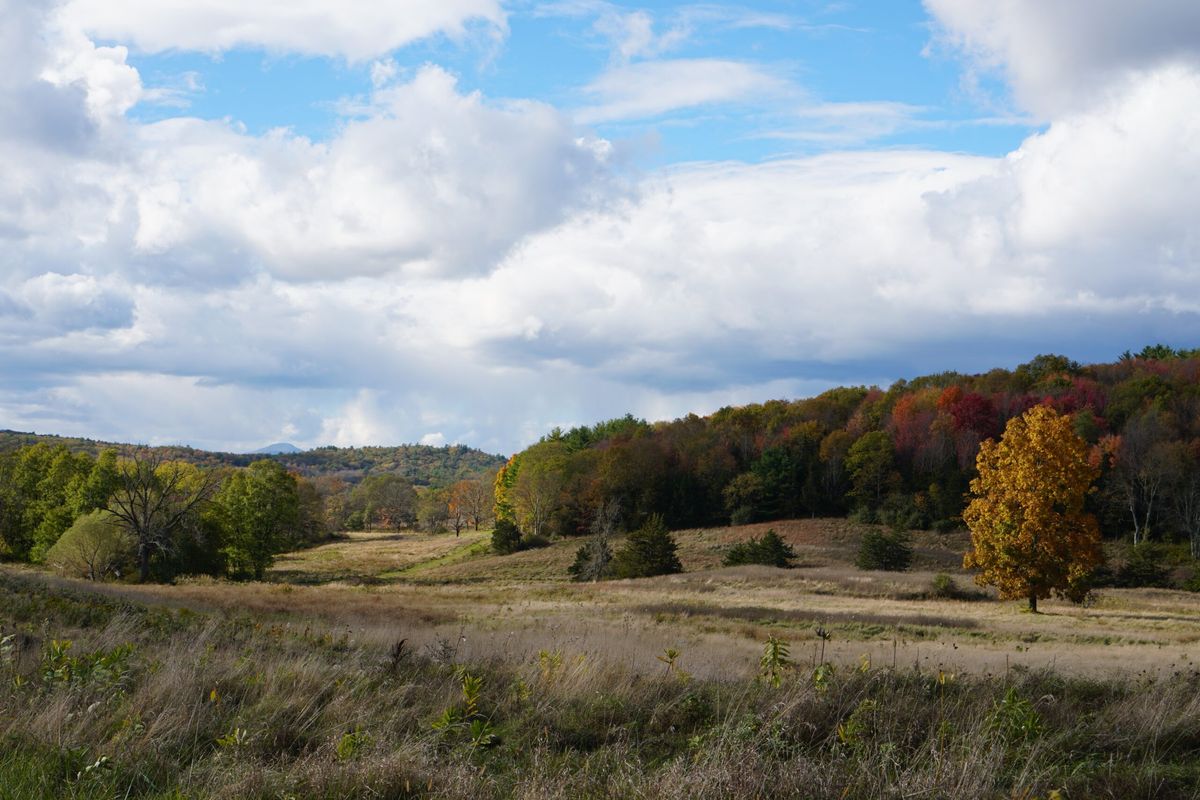Durst lists 1,946 acres for sale in Pine Plains and Milan, N.Y.

Once part of Thomas Carvel’s ill-fated Sports City development, the property has been the subject of debates for decades.
Patrick Grego/New Pine Plains Herald

Once part of Thomas Carvel’s ill-fated Sports City development, the property has been the subject of debates for decades.
This story was originally published in The New Pine Plains Herald.
In a move that could reshape the future of Pine Plains and its surrounding communities, The Durst Organization has listed its expansive property for $36 million. Put on the market on Oct. 14, the former Carvel estate spans 1,490 acres in Pine Plains and 456 acres in Milan, and has long been at the center of debates over land use and preservation.
“We have decided to list the property for sale as we are currently focused on our New York City portfolio, specifically the development of Halletts Point in Astoria, Queens,” Alexander Durst, principal and chief development officer at The Durst Organization, told the Herald. “Another property owner may be able to realize the full potential of this remarkable property. The Durst family has a longstanding appreciation for the Hudson Valley and we will continue to be a part of the community.”
The Durst Organization is one of the oldest family-run commercial and residential real estate companies in New York state. Established in 1915, its portfolio includes the New York City properties of One World Trade Center and The Bank of America Tower.
The company owns approximately 2,633 acres of land in Pine Plains, representing about 13% of the town’s total acreage, according to Dutchess County tax records.
The Dursts initially purchased the 1,900-acre core of the listed property from the estate of the late ice cream magnate Thomas Carvel, in 2002 for $7.78 million.
After the initial acquisition, The Durst Organization expanded its holdings in Pine Plains, purchasing an additional 711 acres between 2015 and 2019 for nearly $6 million. The property is owned by two limited liability companies: 1133 Taconic LLC and Stissing Mountain Properties LLC.
In the late 1960s, Thomas Carvel launched an ambitious development known as the All-American Sports City after acquiring several parcels of farmland in Pine Plains. His vision included a golf course, clubhouse, lake and 500 homes. While the lake, golf course, clubhouse and 16 homes were built, the broader project stalled and remained incomplete at the time of Carvel’s death in 1990. In the decades that followed, the property’s infrastructure — including roads, water, and wastewater systems — fell into disrepair due to neglect, ultimately leaving it in a deteriorated state by the time it was sold.
While the listed property encompasses the original Carvel property, it does not include 685 additional acres in Pine Plains that remain under Durst ownership. Separately, in early October, the company listed another property, featuring a historic 19th-century farmhouse on 65 acres at 115-133 Mount Ross Road, for $599,000.
The company touts the Carvel property as a “sanctuary offering endless possibilities,” with potential uses including a family compound, corporate retreat, or winery. The listing highlights the property’s views of the Catskills and Stissing Mountain, as well as its remaining structures — following the demolition of several houses and barns over the years — which include four single-family homes, a two-family residence, and an office and warehouse facility.
Over the past two decades, The Durst Organization has put forward three development proposals for the Carvel property and its expanded holdings. While each plan was scaled back in response to public concerns, the company worked to incorporate community feedback and adjust its vision accordingly. The final plan, submitted in 2020, envisioned a 2,700-acre “eco resort” including open space, farmland, outdoor recreation areas, and 237 residential lots in Pine Plains, along with 51 lots in Milan. While the project received preliminary approval from the Pine Plains Zoning Board, it went no further.
The first proposal, in 2003 was for a 951-unit residential development centered around Lake Carvel and prompted Pine Plains to impose a moratorium on development and, eventually, to implement zoning laws for the first time.
The new zoning code, passed in October 2009, included some of the strictest regulations in Dutchess County, limiting building sizes and preventing large-scale commercial projects. The Dursts returned in 2011 with a revised plan for 591 units, in compliance with the new zoning code, but in the face of public opposition, and the stock market collapse of 2011, that proposal lay dormant for nearly seven years.
In the first half of 2018, The Durst Organization tried to revive the project, hosting two public meetings at the Pine Plains Community Center to receive feedback from residents. In June 2018, the company presented a new proposal, a “conservation subdivision,” that included plans to restore the golf course Carvel had built in the 1960s and construct 281 homes, placed in small clusters, around a central “recreation-oriented resort.”
In April 2020, The Durst Organization submitted pre-sketch plans for the conservation subdivision to the Planning Board. This stage focused on determining the maximum number of residential lots permitted under Pine Plains zoning laws, with the Dursts proposing 223 lots.
By June 2020, the Planning Board had unanimously endorsed the pre-sketch plan, which designated more than 50% of the land — about 1,397 acres — as open space. The designated areas included wetlands, steep slopes and buffer zones around water bodies. This approval allowed The Durst Organization to proceed with developing a formal subdivision plan, which would undergo a full environmental review before any final decisions were made.
However, after the property was listed Monday afternoon, Oct. 14, it seems as though the back and forth has come to an end — for now.
“The Pine Plains countryside is an oasis in the Hudson Valley,” Durst said. “With 1,946 acres of land in an ideal location and unmatched natural beauty, the property offers the opportunity to create something special.”
As for what kind of buyer would purchase a property of this size? “It’s going to range,” said listing agent Larry Havens. “I don’t want to set any limitations on that.”
The Salisbury Winter Sports Association (SWSA) will host its annual Junior Jump Camp, a two-day introduction to ski jumping, on Saturday and Sunday, Dec. 27 and 28, from 9 a.m. to 2 p.m. at Satre Hill in Salisbury.
The camp is open to children ages 7 and up and focuses on teaching the basics of ski jumping, with an emphasis on safety, balance and control, using SWSA’s smallest hill. No prior experience is required.
The cost is $50 per child and includes instruction and lunch on both days. For more information or to register, visit www.skireg.com/swsa-camp or email info@jumpfest.org
Jesse Bunce, first selectman of North Canaan.
LITCHFIELD — The Northwest Hills Council of Governments welcomed six newly elected municipal leaders Thursday, Dec. 11, at its first meeting following the 2025 municipal elections.
The council — a regional planning body representing 21 towns in northwest Connecticut — coordinates transportation, emergency planning, housing, economic development and other shared municipal services.
Barkhamsted First Selectman Meaghan Cook, Goshen First Selectman Seth Breakell, Kent First Selectman Eric Epstein, Norfolk First Selectman Henry Tirrell, North Canaan First Selectman Jesse Bunce and Torrington Mayor Molly Spino were each elected to their post in November.
They filled the seats of their predecessors on the COG, who were each given a toast of appreciation: Nick Lukiwsky (Barkhamsted), Todd Carusillo (Goshen), Marty Lindenmeyer (Kent), Matt Riiska (Norfolk), Brian Ohler (North Canaan) and Elinor Carbone (Torrington).
COG Executive Director Rob Phillips said the outgoing members were given a going away mug that read “You’re living the dream still.” Members voted to appoint Warren First Selectman Greg LaCava to fill a vacancy on the Council’s Executive Committee. COG members voted by paper ballot, and LaCava defeated Burlington First Selectman Doug Thompson for the vacant seat.
Ryan Segalla takes a fadeaway shot over a defender.
FALLS VILLAGE — Housatonic Valley Regional High School’s boys basketball team defeated Pine Plains High School 60-22 in a scrimmage Tuesday, Dec. 9. The non-league preseason game gave both sides an opportunity to run the court ahead of the 2025-26 varsity season.
HVRHS’s senior-heavy roster played with power and poise. The boys pulled ahead early and kept their foot on the gas through to the end.
By halftime the score was 33-8. Junior varsity players subbed in for the second half, but not before the starters got some in-game dunk practice. By the end Housatonic totaled 60 points to Pine Plains’ 22.

Nick Crodelle led the Mountaineers offensively with 13 points. Anthony Labbadia and Wyatt Bayer scored nine points each. Anthony Foley scored eight points. Owen Riemer and Ryan Segalla each scored seven points. Peyton Bushnell hit a three-pointer. Jaxon Visockis and Henry Berry each scored two points.
HVRHS begins Berkshire League competition on the road at Nonnewaug High School Tuesday, Dec. 16, with a 6 p.m. tip off.


Katie Moore delivers toys to the Stuff a Truck campaign held by the Kent Volunteer Fire Department last weekend. Donated toys are collected so that parents, who need some assistance, may provide their children with gifts this Christmas. Accepting the donation are elves Fran Goodsell and Karen Iannucci
KENT — Santa’s elves were toasty warm as they collected toys for the children of Kent.
Keeping with annual tradition, Fran Goodsell and Karen Iannucci manned the Stuff a Truck campaign sponsored by the Kent Volunteer Fire Department on Saturday, Dec. 6, and Sunday, Dec. 7. Sitting in front of a fire pit in the firehouse parking lot between donations from residents, they spoke of the incredible generosity displayed every season. That spirit of giving was clear from the piles of toys heaped on a table.
“This is always so gratifying,” said Goodsell, noting that certain businesses, including High Watch Recovery Center, Wilson’s, and Kent and South Kent schools needed a “shout out” for all they’ve done. She said South Kent School focuses on gifts for older children, which is a group that often is overlooked.
Unwrapped contributions are sought for children 1 to 15 years old who might otherwise find little or nothing from Santa, they said. The bounty will be set up at the Community House on Thursday, allowing parents to come and take what they want. If there are still items left, grandparents are invited to “shop.”
The atmosphere was festive Saturday, as a stuffed dog began barking a Christmas tune whenever someone walked in front of it. A large decked-out bear posted at the parking lot entrance reminded passersby of the event. Visiting children were able to get a close-up look at the fire truck and walk through the firehouse if they wished.
Goodsell and Iannucci were very grateful to those who donated wood for the fire pit. “And so many asked if they could bring us coffee or hot chocolate,” said Iannucci.
Goodsell said many who came talked about having grown children who were recipients of the gifts when their families were struggling. “They are so glad to be able to give back,” she said.